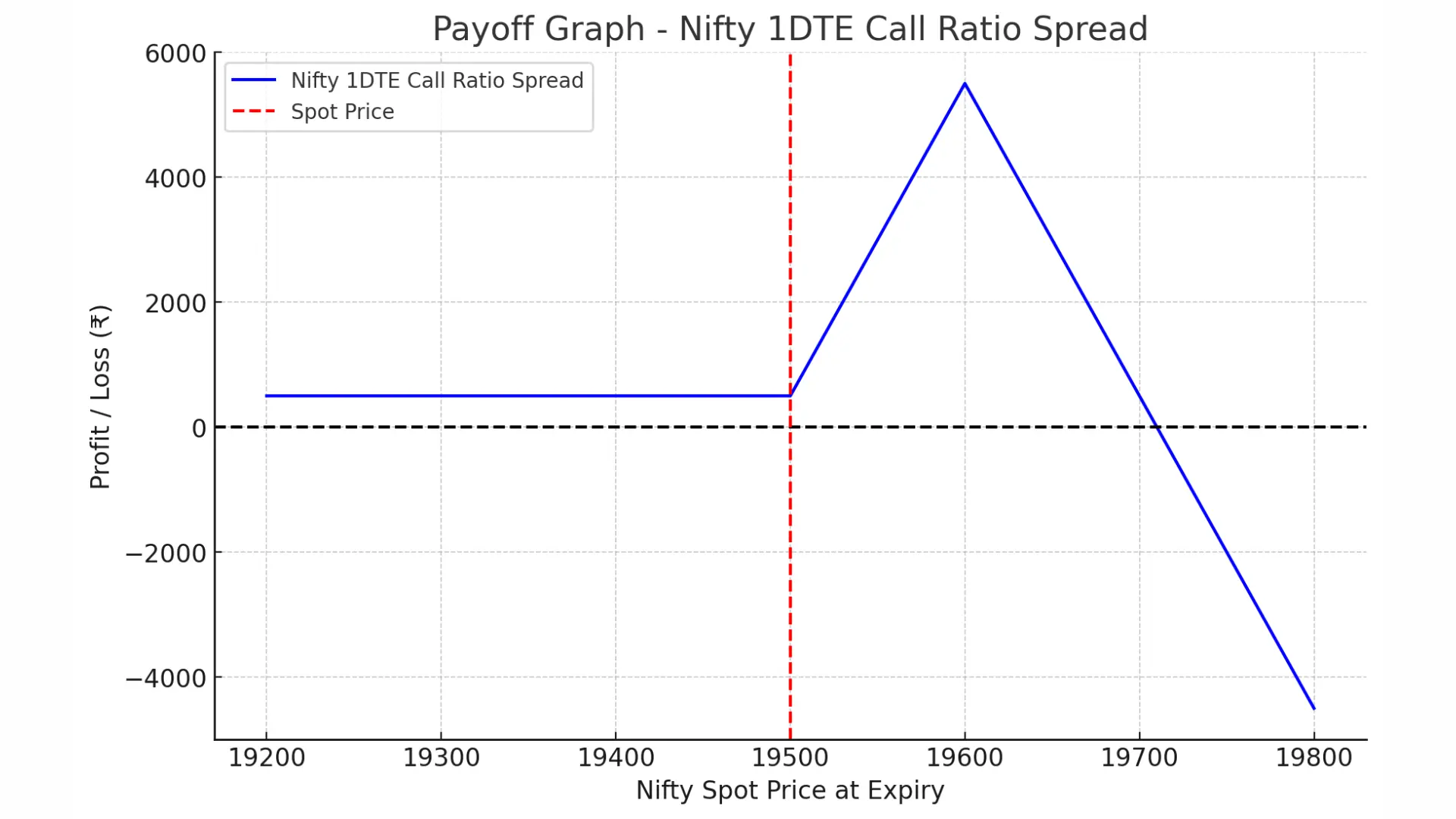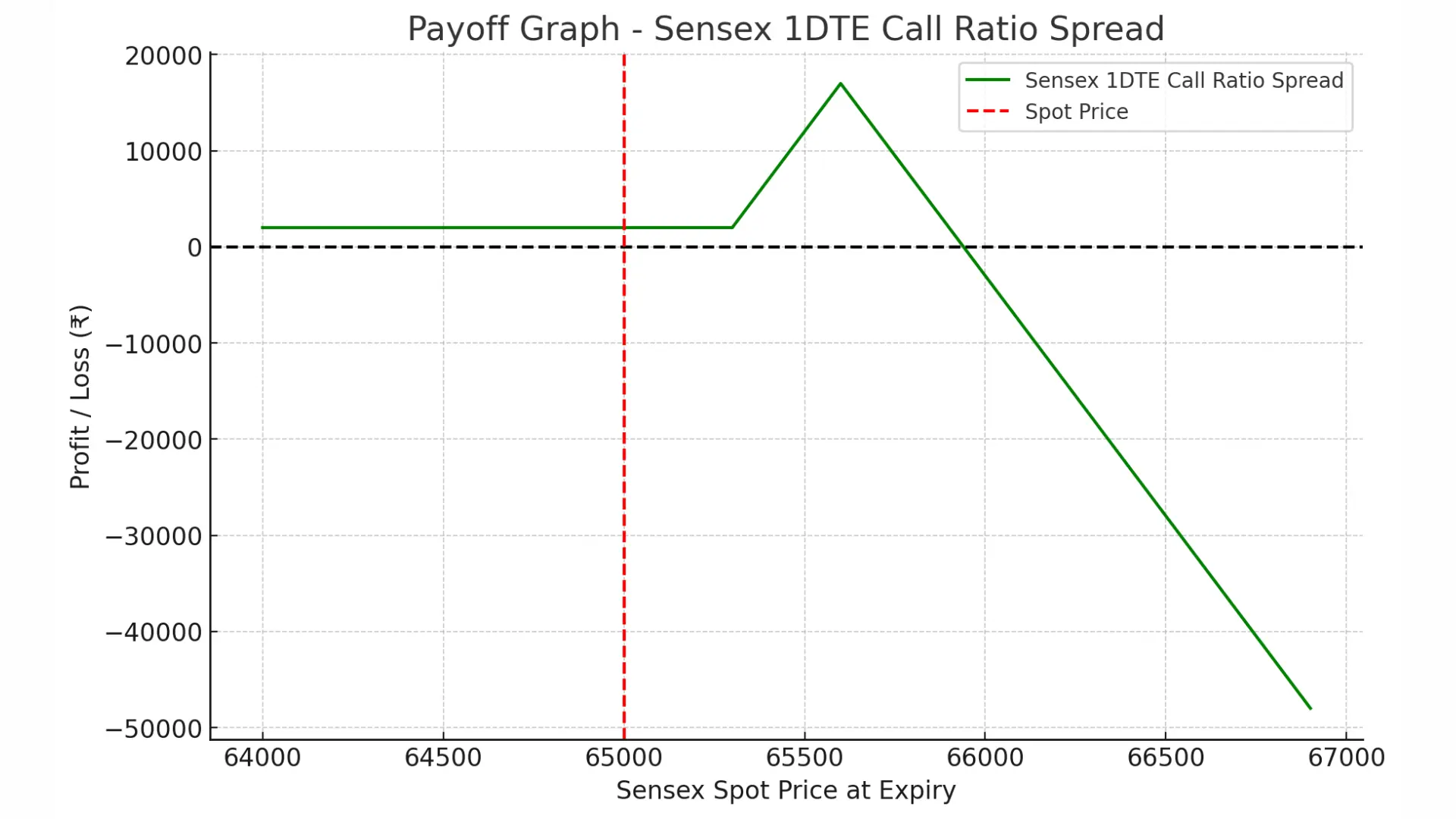Table of Contents
- What is a 1 DTE Call Ratio Spread?
- When to Use This Strategy
- Entry & Exit Rules
- Given Legs (Detailed Tables)
- Two Practical Examples
- Risk Management & Tips
- FAQ
- Conclusion
Short, practical, and expiry-focused: The 1 DTE Call Ratio Spread is a high-probability, short-duration options setup ideal for traders expecting limited upside or range-bound movement during expiry week.
What is a 1 DTE Call Ratio Spread?
A Call Ratio Spread involves buying one call (usually ATM or near-ATM) and selling two calls further out-of-the-money (OTM). When deployed with 1 day to expiry (1 DTE), it becomes a short-duration trade that profits from accelerated time decay (theta) and small or no upside movement.
When to Use This Strategy
- Volatility (VIX): Preferably low (for example, VIX < 13).
- Market bias: Bearish to sideways or mildly bullish.
- Timing: Best placed 1–2 days before expiry (1 DTE trades are time-sensitive).
Entry & Exit Rules
Nifty Setup (Suggested)
- Entry time: 3:15 PM on Friday (or 1–2 days before expiry).
- Legs: Buy 1 ATM Call (min premium ₹80). Sell 2 OTM Calls 100 points away (each premium >50% of bought call premium).
- Validity: Ensure a net credit at entry. If net debit, skip the trade.
- Exit: Target profit 0.3%–0.4% of deployed capital. Stop loss 0.3% of capital.
Sensex Setup (Suggested)
- Entry time: 3:15 PM on Tuesday (or 1–2 days before expiry).
- Legs: Buy 1 OTM Call (300 points from ATM; min premium ₹200). Sell 2 OTM Calls another 300 points away (each premium >50% of bought call premium).
- Exit: Same targets as Nifty — profit target 0.3%–0.4%, stop loss 0.3%.
Given Legs — Leg Details Table
Nifty — 1 DTE Call Ratio Spread (Legs)
| Leg | Action | Strike (example) | Lots | Notes |
|---|---|---|---|---|
| 1 | Buy Call | ATM (e.g., 19,500 CE) | 1 Lot | Minimum premium ₹80 (Delta ~0.30) |
| 2 | Sell Call | ATM + 100 pts (e.g., 19,600 CE) | 2 Lots | Each premium >50% of bought call premium |
Sensex — 1 DTE Call Ratio Spread (Legs)
| Leg | Action | Strike (example) | Lots | Notes |
|---|---|---|---|---|
| 1 | Buy Call | ATM + 300 pts (e.g., 65,300 CE) | 1 Lot | Minimum premium ₹200 |
| 2 | Sell Call | ATM + 600 pts (e.g., 65,600 CE) | 2 Lots | Each premium >50% of bought call premium |
Two Practical Examples
Example 1 — Nifty 1 DTE Call Ratio Spread
Spot: Nifty @ 19,500
| Leg | Action | Strike | Premium (₹) |
|---|---|---|---|
| Buy | 1 Lot | 19,500 CE | 100 |
| Sell | 2 Lots | 19,600 CE | 55 each (total ₹110) |
| Net Credit: ₹10 (₹110 - ₹100) | |||
Outcome: If Nifty remains around 19,500–19,600 at expiry → time decay works in your favour. If Nifty rallies strongly above 19,600 → limited loss beyond breakeven; if Nifty falls → profit equals net credit.
Here are the effective payoff graphs for your examples:

Nifty 1DTE Call Ratio Spread – Buy 19500CE, Sell 2x 19600CE
✅ Clear profit/loss curve
✅ Breakeven levels marked
✅ Spot price highlighted
Example 2 — Sensex 1 DTE Call Ratio Spread
Spot: Sensex @ 65,000
| Leg | Action | Strike | Premium (₹) |
|---|---|---|---|
| Buy | 1 Lot | 65,300 CE | 220 |
| Sell | 2 Lots | 65,600 CE | 120 each (total ₹240) |
| Net Credit: ₹20 (₹240 - ₹220) | |||
Outcome: If Sensex closes between 65,300–65,600 → maximum profit. If it rises beyond 65,600 → limited losses; if it falls → profit equals net credit.
Here are the effective payoff graphs for your examples:

Sensex 1DTE Call Ratio Spread – Buy 65300CE, Sell 2x 65600CE
✅ Clear profit/loss curve
✅ Breakeven levels marked
✅ Spot price highlighted
Risk Management & Practical Tips
- Always confirm net credit before taking the trade.
- Keep capital aside for adjustments. 1 DTE trades can move fast — be ready.
- Set strict profit targets and stop-loss levels (suggested: 0.3%–0.4% target, 0.3% stop-loss of deployed capital).
- Use limit orders to avoid slippage on short-duration trades.
- Avoid trading before major news/events even in 1 DTE setups.
FAQ — Frequently Asked Questions
Q1: Is the 1 DTE Call Ratio Spread risky?
A: Like all options strategies, it carries risk. Because you sell more calls than you buy, extreme upside moves can cause losses. Using strict stop-loss and capital allocation limits that risk.
Q2: Can this be used in high volatility?
A: It’s best in low-to-moderate volatility. High volatility increases premiums and the chance of sharp moves.
Q3: What if the trade shows a net debit at entry?
A: Skip the trade. The premise of the strategy is a net credit entry that benefits from theta decay.
Q4: How much capital do I need for 1 DTE trades?
A: Capital depends on the lot sizes and margin rules of your broker. Keep enough to cover margin requirements and possible adjustments.
Q5: How do I manage assignment risk?
A: For index options in India (Nifty/Sensex), physical assignment is not an issue as these are cash-settled. For stock options, be aware of assignment risk and manage position size.
Conclusion
The 1 DTE Call Ratio Spread is a focused, short-duration strategy that seeks to capture time decay in expiry week while limiting downside through a conservative long call. With clear entry/exit rules, strict risk management and capital reserved for adjustments, this strategy can generate consistent returns in range-bound or mildly bullish markets.
Note: This content is educational and not investment advice. Always test strategies on paper or in a small live size and consult a licensed advisor if required.
— End of article —

